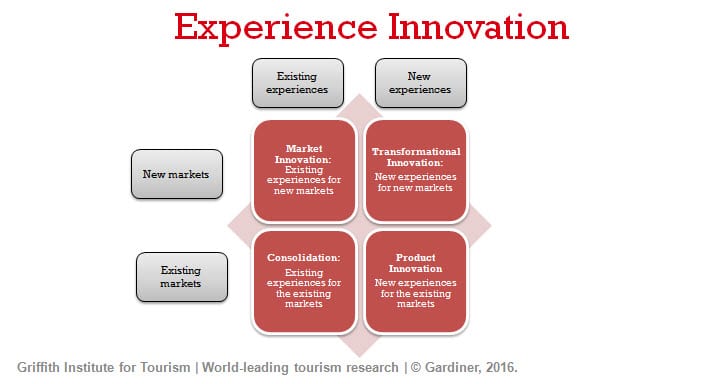Does tourism suffer from the innovator’s dilemma?
A couple of years ago, we were commissioned to build an evidence-based marketing plan for a tour operator.
At the time, they were highly successful but an external review had identified that they lacked process and a way to drive the next wave of growth. This was where we came in.
When we sat down for our inception meeting, I commented how excited I was to be working with a business at this stage of the business cycle. This is exactly the time a business should scan the horizon looking for the next wave of growth. But it’s actually hard to change when you’re successful – it’s all going well, all you need to do is keeping raking in the profits. The problem is that when the environment changes and you NEED to change, then often you have a lot fewer resources and less room to move. This problem is so well understood in management circles it even has a name: ‘The Innovator’s Dilemma’ based on the book by Clayton M. Christenson.
So when a tourism manager recently said to me that his non-tourism stakeholders perceived that tourism is slow to innovate it got me thinking. Do we as an industry suffer from Innovator’s Dilemma? And if we do, what should we do about it?
Is Tourism an innovative sector?
My initial reaction was yes. Of course, we are an innovative industry. If you consider the airline industry to be part of tourism then we were among the first industries in the world to practice a form of dynamic pricing and, as a result, yield and revenue management; among the first to practice relationship management (in the form of loyalty programmes) and our products have evolved alongside the consumer in many areas. Products like G Adventures and Intrepid Travel updated the model of the group tour for a new generation. Google considers the travel category to be at the forefront of driving the digital revolution. Airbnb and Uber are after all in the tourism and transportation sector.
But then I began to think… Actually, you could argue
- It’s the passion consumers have for the travel category that is driving digital uptake along with the natural characteristics of our product – rich and meaningful experiences. A lot of people in the travel industry are still highly wary about the digital world.
- Airbnb and Uber are actually classic disruptors i.e. they came from OUTSIDE the industry and disrupted it because they spotted an opportunity no one on the inside had. So they actually prove the opposite – we ARE subject to the Innovator’s dilemma.
As usual, the truth is not so clear cut – we are an industry with some great innovators, but we have a wide swath of the industry that is currently unconvinced of the need to innovate.
So how do we change that and make the tourism industry more innovative?
It starts with understanding what we mean by innovation
Dr. Sarah Gardiner of Griffith University touched on this in the fantastic webinar she did for us as part of our Innovation Month (available to MTR members as a recording here).
Innovation can sound like it is A Big Thing. As tourism is a sector dominated by small to medium businesses and often ones that do it for love rather than global domination, big things can seem scary.
But as I learned when researching innovation it can be large or small. The question we used to ask is ‘are we talking about innovation like the Internet or innovation like adding wheels to suitcases’? Dr. Gardiner’s advice is to start small and learn the habit of innovation.
Think about all the places you could innovate
Dr. Gardiner suggested considering this along two dimensions – the markets you serve and the products or experiences you offer.
- Do you need to reach a new market? The growth of the Chinese FIT market is a classic example of this. It’s a large and dynamic market but will your product work? Do you need to adapt it?
- Even an established market can change: as older traditional style Grey Nomads start to (literally) die off, how are you going to attract the first Lonely Planet generation?
But alongside these outward-facing elements, innovation can also be about you. Sometimes even the smallest tweaks in business processes can have a major improvement on costs or productivity. We all know the story of the airline who saved $40m by reducing the amount of salad on its food trays simply by doing an audit of the rubbish it took off planes (just don’t touch the chocolate!)
Use evidence and put everything in context
The Henry Ford quotation about asking the public what they want and getting a faster horse is often used to suggest that market research isn’t helpful in innovation. Actually, there is no evidence Henry Ford ever did say it. And General Motors actually almost sent him bankrupt when it used research to drive innovation that better met customer needs. The challenge is to ask what type of insight best drives innovation. Not all of it needs to cost a lot.
The best way to do this is to try to see the world through your customer’s eyes. Doctor Gardiner cited the example of an Australian surf school that
wanted to attract that new Chinese market. Most Australians live on the coast and grow up with the sea, so frolicking in large waves and body surfing comes naturally. It is safe to say that this is not true for most Chinese visitors. Furthermore, surfing wasn’t an aspiration for many of them on holiday – for most what they wanted was to live like a local: mucking about in the sea and body surfing. So by focusing on training Chinese tourists to enjoy this they got a far greater result for their business.
A further insight was around attitudes to exposing their bodies to the sun. By adding long-sleeved rashies (sun blocking tops) they dealt with a major barrier. A great example of that small-scale innovation we talked about.
Channel your inner Arthur C Clarke or Philip K Dick
Many years ago the British Government did a review of what predicted success in innovation. It found that consistently the best predictor of innovation is actually science fiction. Almost every weird thing that appears in a Philip K. Dick story actually exists in our world today. What we dream about or greatly fear activates deep emotions in our brain – and helps us find ways to achieve or avoid them.
So look at those big fears and hopes and ask yourself what could I do about that?
This applies to your broader business as well. In our Tourism Marketing Plan Blueprint we identified more than 40 trends that would fit in the situational analysis for any destination or tourism business. Then a critical need from the coaching calls that come with the plan was to help people pick their way through the 40. It’s a spoiler but this is one of the most important pieces of advice we give people.
Go to the extreme
The people who are happy with your product are not usually the ones who can help you solve a problem.
The cliché is true: it’s grit that creates pearls. There are three sources of grit that can help you make profitable pearls. In all three the common denominator is to look to the pain points.
- The customers who complain or reject you. What are the reasons they are doing so? Do you see any common patterns? What would it cost to solve that problem? What would you gain if you solved it?
- The customers who are generally happy but are honest enough to tell you what you could do better. Again, look at the patterns and see if you can solve them.
 Your staff and your suppliers, particularly those who query or challenge things a lot. Front line staff is statistically proven to have the best understanding of customer needs. Getting them to provide input not only gives you a fresh perspective, it will mean they join in.
Your staff and your suppliers, particularly those who query or challenge things a lot. Front line staff is statistically proven to have the best understanding of customer needs. Getting them to provide input not only gives you a fresh perspective, it will mean they join in.
You should also think about creating a little grit yourself by asking someone who’s really on the cutting edge or has specialist expertise to help you.
Test, set, repeat
It’s important to test your idea either conceptually or via a prototype. A great idea is to run a ‘pre mortem’ get a mix of people together (internal if you have them, friends and partners if not) and imagine the problem has gone wrong. Test to find the points where it isn’t working.
Keep watching and learning. If your innovations are in the digital space you can make small modifications quite quickly and see if they work.
Be a meerkat, not an ostrich
The most effective way to innovate in the long term is to use all these steps to fuse innovation into your business.
Meerkats are the ideal example here… They are always working together to scan the horizon and work in teams to do so. In the harsh environment of the desert or savannah that has given them a distinct survival advantage.
And the final piece of advice is perhaps the one we should have given first. Be prepared to change. Because without that willingness it won’t ever work.








Fabulous article Carolyn – my experience is that traditionally more innovation in tourism comes from outside the “industry” than from within, with much originating from consumers dissatisfied with the status quo or from those with more technological awareness/competence who can see huge opportunities in a sector that connects people physically.
Historically, this pattern reflected the hierarchical, command and control organisational structure of many companies and agencies where pride was taken in the need to “work one’s way up the ladder and learn the hard way” and both policies and behaviours were devised by senior management and dished out as scripts & dictums “this is the way things are done around here”. As more and more Millennials, who live and breathe networks, connectivity and sharing, rise through the ranks, and are given the freedom to demonstrate their creativity, we’ll see real transformation. It’s got to be one of the most exciting times to be in tourism.
Hi Anna
Thanks for the great feedback. I sincerely hope that you are right. The key take out from your feedback to me is that it is vital that we give them (and increasingly they create for themselves) the culture that values ideas. I spent many years in corporate cultures where ‘drinking the Kool Aid’ was seen as the ultimate loyalty test and way to achieve promotion. (Does that make me an Ageless Millennial I ask myself?) Divergent thinking was seen as disloyalty.
So I guess based on your feedback it is important for all tourism businesses to think how they can create the culture for innovation. A team member of mine taught me a great quote – Culture eats strategy for breakfast. I don’t know its origins but I see it so many times.
I’ve always found exciting times in tourism but I agree the alignment of technology and generational change is creating many new opportunities!
Carolyn
You’re spot on. It was Peter Drucker’s quote on culture eating strategy for breakfast. A wise source indeed. Innovation ideas emerge in cultures where diversity is welcomed and experimentation and risk taking encouraged. But the latter don’t occur unless there is “psychological safety” – the core factor that Google found was necessary to create “high performing teams.” We’re not lacking in evidence but in will and some guidance as to how. That’s where my focus is going. A blog post that refers back to your Meerkats is on its way!
PS – glad to see you’ll be on the podium at PATA!
Thanks Anna. I can’t wait to see it.
Yes, that is something I was taught when I did the Interaction Associates training on facilitative leadership and have applied to all the workshops I have done since. Creating an atmosphere of trust is vital – not just to courage to speak out but also to freeing the brain. When we are in an environment where we have trust we literally think differently. Another wise guru talked about this in the overall management structure. I once heard Suhantra Ghoshal (no longer with us) make the memorable comparison between spring in Fontainebleau Forest near his professorship with INSEAD and pre-Monsoon weather in his childhood home of Calctta. He said that “most companies want to create Fontainebleau in the spring, what they actually create is Calcutta before the monsoon’. It’s stayed with me ever since and informed my own thinking as a leader.
Hope to meet you in person in AKL on 30 Sep! (And anyone else reading this reply who shares Anna’s and my mutual passion for ideas that make our industry better)